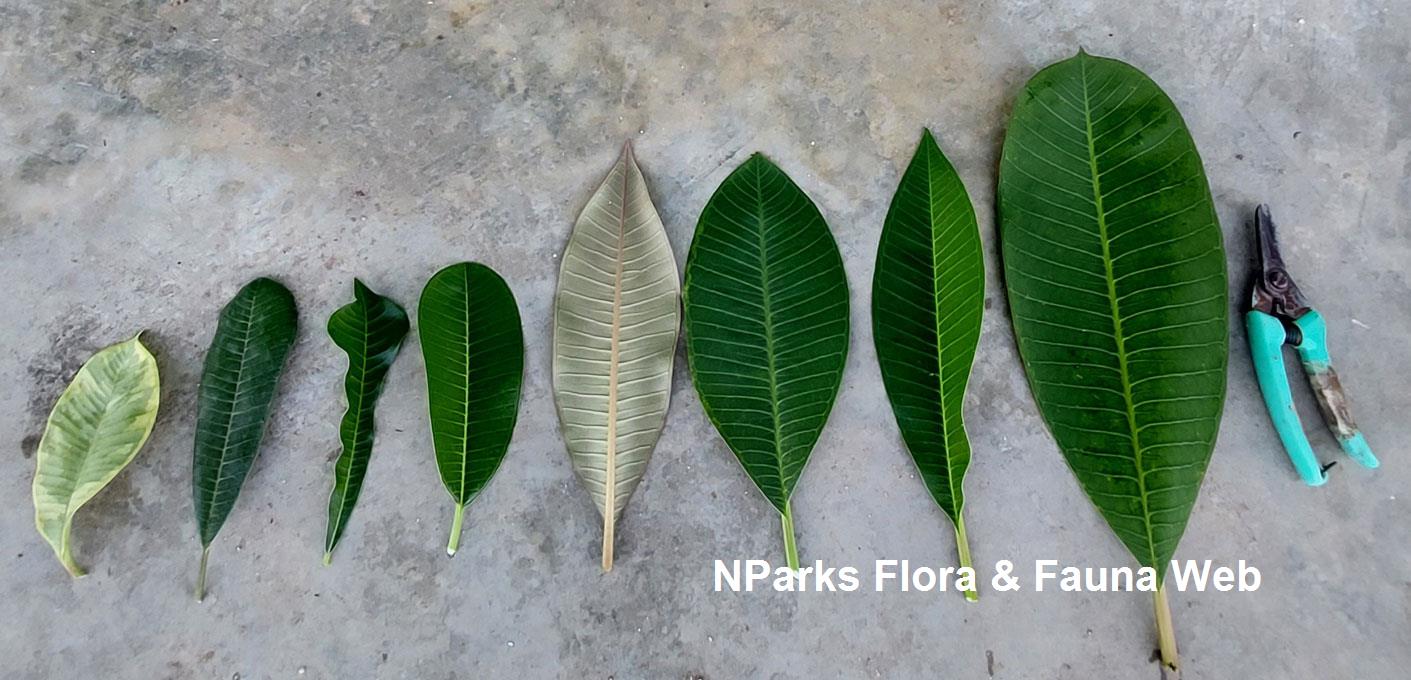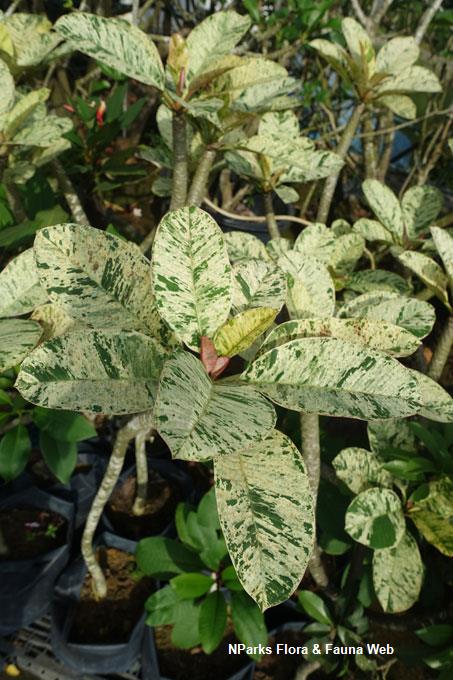
Back
Plumeria cultivars
| Family Name: | Apocynaceae |
| Common Name: | Frangipani, Graveyard Flower, Plumeria, 鸡蛋花属 |
Plumeria generally known as Frangipani is a genus from the Apocynaceae (Milkweed) family. It consist of small to medium sized trees that exude a white milky sap when bruised. Leaves comes in various shapes and sizes; some are lance-shaped, spoon or egg-like in appearance. Flowers are 5 petalled, large and waxy. It has a sweet fragrance with hints of jasmine, citrus and gardenia which intensifies during the evening. This genus produce horn-like seed pods that spilt upon maturity, releasing 20 - 60 flat winged seeds.
Name
Classifications and Characteristics
| Plant Division | Angiosperms (Flowering Seed Plants) (Dicotyledon) |
|---|---|
| Plant Growth Form | Tree (Small (6m-15m)) |
| Maximum Height | 12 m |
Biogeography
| Native Distribution | Mexico to Northern South America, Florida to Caribbean |
|---|---|
| Native Habitat | Terrestrial |
| Preferred Climate Zone | Tropical |
| Local Conservation Status | Non-native |
Description and Ethnobotany
| Growth Form | The genus is made of trees with a small to medium-sized stature. They exudate a white milky sap when bruised or pruned. The species and cultivars of Plumeria varies in form; appearing upright and compact or open and sprawling. |
|---|---|
| Foliage | Leaves are leathery to fleshy, comes in a range of shapes such as egg, lance or spoon-shaped. Leaf margin is smooth ending with a round to pointed leaf tip. The alternately arranged foliage are concentrated on branch tips, scars are left behind when the older leaves fall off. |
| Flowers | Flowers are large, waxy and tubular. Colours include white, yellow, red, pink or bicoloured. Borne on a thyrsiform inflorescence, the 5 petalled flowers are fragrant, with hints of of jasmine, citrus and gardenia. While the flowers remain fragrant all day, the scent is strongest during the evenings. |
| Fruit | It has seed pods that resembles a pair of horns. They are hard, cylindrical, leathery to woody follicles that grows to 20 cm long. Upon maturity, it splits lengthwise releasing 20 - 60 flat, irregularly winged seeds. It is observed that some cultivated varieties rarely fruit. |
| Cultivation | Frangipanis are sun-loving species that thrive in moist well drained soil. Overwatering or soggy soil subject the tree to root rot, hence loose media are preferred when growing in containers. Apply high phosphorous fertiliser according to the product label to promote flowering. A layer of mulch around the base of the tree can reduce the susceptibility of rust infection, common to Plumeria genus. |
| Etymology | The genus name, Plumeria was named in honour of Charles Plumier (1646-1704), French monk of the Franciscan order, botanist and traveller. |
Landscaping Features
| Desirable Plant Features | Fragrant, Ornamental Flowers |
|---|---|
| Landscape Uses | Container Planting, Focal Plant, Parks & Gardens |
| Usage Hazard - Cons | Irritant - Sap |
Plant Care and Propagation
| Light Preference | Full Sun |
|---|---|
| Water Preference | Moderate Water |
| Plant Growth Rate | Moderate |
| Rootzone Tolerance | Fertile Loamy Soils, Moist Soils, Well-Drained Soils |
| Propagation Method | Air-Layering, Grafting, Stem Cutting |
Foliar
| Foliage Retention | Evergreen |
|---|---|
| Mature Foliage Colour(s) | Green |
| Foliar Type | Simple / Unifoliate |
| Foliar Arrangement Along Stem | Alternate |
| Foliar Attachment to Stem | Petiolate, Sessile |
| Foliar Shape(s) | |
| Foliar Venation | Pinnate / Net |
| Foliar Margin | Entire |
| Foliar Apex - Tip | Acuminate, Rounded |
| Foliar Base | Attenuate, Cuneate, Oblique / Asymmetrical |
Non - Foliar and Storage
| Stem Type & Modification | Woody |
|---|---|
| Root Type | Underground (Fibrous Root) |
Floral (Angiosperm)
| Flower & Plant Sexuality | Bisexual Flowers , Bisexual Flowers |
| Flower Colour(s) | Cream / Off-White, Orange, Patterned, Pink, Red, White, Yellow / Golden |
|---|
| Flower Texture(s) | Waxy |
| Flower Grouping | Cluster / Inflorescence |
| Flower Location | Terminal |
| Flower Symmetry | Radial |
| Individual Flower Shape | Salverform |
| Inflorescence Type | Thryse |
| Flowering Period | Free-Flowering |
| Flowering Habit | Polycarpic |
Fruit, Seed and Spore
| Mature Fruit Colour(s) | Green |
|---|---|
| Mature Fruit Texture(s) | Leathery |
| Fruit Classification | Simple Fruit |
| Fruit Type | |
| Mature Seed Colour(s) | Brown, Cream / Off-White |
| Mature Seed Texture(s) | Papery |
| Seed Quantity Per Fruit | Numerous (>20) |
References
| References | Stoffers, A.L. (1982). Apocynaceae. Flora of the Netherlands Antilles, 2(3), pp. 302-314. Royal Botanic Gardens, Kew (continuously updated). Plants of the World Online | Kew Science. https://powo.science.kew.org/taxon/urn:lsid:ipni.org:names:30001863-2. Accessed 24 Feburary 2022. |
|---|
Image Repository
Others
| Master ID | 34207 |
|---|---|
| Species ID | 8620 |
| Flora Disclaimer | The information in this website has been compiled from reliable sources, such as reference works on medicinal plants. It is not a substitute for medical advice or treatment and NParks does not purport to provide any medical advice. Readers should always consult his/her physician before using or consuming a plant for medicinal purposes. |

.jpg)
.jpg)
.jpg)
.jpg)
.jpg)
.jpg)
.jpg)
.jpg)
.jpg)
.jpg)
.jpg)
.jpg)
.jpg)
.jpg)
.jpg)
.jpg)
.jpg)
.jpg)
.jpg)
.jpg)
.jpg)
.jpg)
.jpg)
.jpg)
.jpg)




